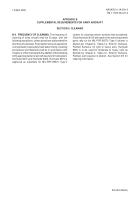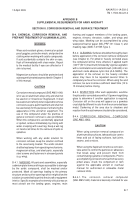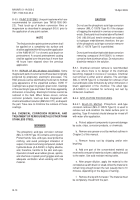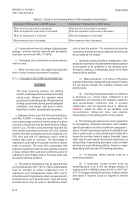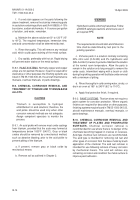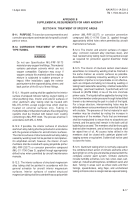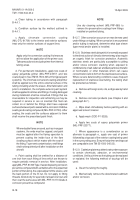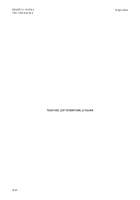TM-1-1500-344-23-2 - Page 214 of 240
B-12
NAVAIR 01-1A-509-2
TM 1-1500-344-23-2
15 April 2009
d. In areas where there is no danger of liquid oxygen
spillage, corrosion may be removed with phosphoric
acid base rust remover (MIL-C-10578).
e. Thoroughly rinse all chemical corrosion remover
from the area.
f. Allow the area to dry, then apply final protective
finish or other corrosion preventive if required.
B-7.3. PICKLING FOR CORROSION REMOVAL.
WARNING
The scale loosening solution, the pickling
solution, and the passivating solution all contain
strong acids. Observe the standard safety
precautions for handling acids. Wear protective
clothing, avoid inhaling fumes, provide adequate
ventilation, and always add acid to water.
Hydrofluoric acid is exceptionally hazardous.
a. Mixtures of nitric acid (O-N-350) and hydrofluoric
acid (MIL-A-24641) in water are recommended. The
correct percentage content of the two acids for a given
corrosion removal job shall be determined by testing.
(See B-7.2.c). The nitric acid content may vary from 5 to
50% and the hydrofluoric acid from 0.5 to 5%, both by
volume. Normally, an aqueous mixture containing 12 to
15% nitric acid and 1% hydrofluoric acid is used to
remove light scale or corrosion. The percentage of
hydrofluoric acid may be increased to remove heavier
scale or corrosion. The more nitric acid present with
respect to hydrofluoric acid, the less rapid the corrosion
or scale removal. Nitric acid acts to inhibit the action of
hydrofluoric acid. Rubber lined or Koroseal tanks may
be used to hold the solutions.
b. The pickling temperature may be adjusted from
room temperature to 140
°
F (60
°
C). Higher temperatures
shall be avoided to reduce evaporation loss of
hydrofluoric acid. Temperatures below 120
°
F (49
°
C)
should be used if intergranular attack is experienced in
localized areas, such as weld zones. Type 300 series
stainless steels may be used to manufacture steam
coils to heat the solution. The heating coils should be
installed so that they are easily replaced since they will
be corroded by the solution.
c. Optimum pickling conditions (temperature, time,
and acid concentration) shall be determined by exposure
of test panels to all conditions of the cleaning cycle.
Excessive etching or intergranular attack of the base
metal shall be avoided.
(1)
Make test panels, 1 x 4 inches, of the same
material as that of the compound being cleaned. Process
the test panels through the complete cleaning and
pickling cycle.
(2)
If etching, intergranular attack, or metal loss
is excessive (i.e., would cause component to be
condemned), or if cleaning is not complete, adjust the
acid concentration, immersion time, or solution
temperature until the desired result is obtained.
Table
B-1 shows the effect of the variables (acid
concentration, immersion time, and solution
temperature) on the pickling action of the solution.
d. The following procedures are merely guidelines
for acid pickling. Competent operators must establish
specific procedures by test as outlined in paragraph c.
above. A scale loosening procedure is included for use
only if severe scale is encountered and it is desired to
loosen the scale by chemical means. Normally, heavy
scale may be removed by mechanical means prior to
acid pickling. A passivating procedure is also included
and may be used following pickling. Solvent or vapor
degreasing shall precede the following procedure:
(1)
If necessary, remove severe scale by a
mechanical method.
(2) If necessary, loosen severe scale by
immersing parts in an 8-10% (by weight) solution of
sulfuric acid (A-A-55828) in water at 150
°
to 160
°
F (66
°
to 71
°
C) for approximately five minutes. Observe results
and repeat if required. Scrub as required to remove
sludge.
e
r
e
v
e
S
E
R
O
M
s
i
n
o
i
t
c
A
g
n
i
l
k
c
i
P
r
o
g
n
i
v
l
o
s
s
i
D
e
r
e
v
e
S
S
S
E
L
s
i
n
o
i
t
c
A
g
n
i
l
k
c
i
P
r
o
g
n
i
v
l
o
s
s
i
D
.
d
e
s
a
e
r
c
e
d
s
i
t
n
e
t
n
o
c
d
i
c
a
c
i
r
t
i
n
e
h
t
n
e
h
W
.
d
e
s
a
e
r
c
n
i
s
i
t
n
e
t
n
o
c
d
i
c
a
c
i
r
o
u
l
f
o
r
d
y
h
e
h
t
n
e
h
W
.
d
e
s
a
e
r
c
n
i
s
i
t
n
e
t
n
o
c
d
i
c
a
c
i
r
t
i
n
e
h
t
n
e
h
W
.
d
e
s
a
e
r
c
e
d
s
i
t
n
e
t
n
o
c
d
i
c
a
c
i
r
o
u
l
f
o
r
d
y
h
e
h
t
n
e
h
W
.
d
e
s
a
e
r
c
n
i
s
i
e
r
u
t
a
r
e
p
m
e
t
e
h
t
n
e
h
W
.
d
e
s
a
e
r
c
e
d
s
i
e
r
u
t
a
r
e
p
m
e
t
e
h
t
n
e
h
W
.
d
e
s
a
e
r
c
n
i
s
i
e
m
i
t
n
o
i
s
r
e
m
m
i
n
e
h
W
.
d
e
s
a
e
r
c
e
d
s
i
e
m
i
t
n
o
i
s
r
e
m
m
i
n
e
h
W
Table B-1. Control of the Dissolving Action of Nitric-Hydrofluoric Acid Solution
Back to Top




